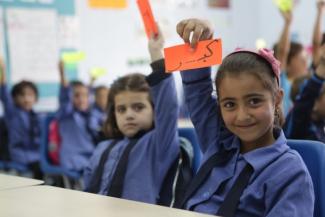BACKGROUND
Jordan’s people are the country’s greatest asset and maximizing their potential to contribute to Jordan’s stability and economic growth is a key priority for the Government of Jordan. Delivering quality education is fundamental to ensuring that the country’s large youth population has the necessary skills to play a positive role in the county’s future. Jordan has made great progress in increasing access to education, with nearly universal primary enrollment and gender parity in Jordanian schools. However, despite widespread access to education, challenges remain. Schools are overcrowded and in varying states of disrepair, teachers receive limited training and support, and learning outcomes remain low. By grade three only 34 percent of children read at grade level. A growing population of Jordanians and the influx of refugees have stressed Jordan’s public education system, and children and youth who fall out of the system lack opportunities to get back on track. The COVID-19 pandemic has added additional pressure on the Ministry of Education to deliver education despite school closures.
In 2018, the Ministry of Education launched its five-year Education Strategic Plan to ensure that all children and youth can gain the skills and knowledge to succeed in a 21st-century knowledge economy. USAID supports the Government of Jordan as it expands access to quality education for children and youth, improves recruitment and training of quality teachers, and develops sustainable and self-sufficient education sector planning and administration.
AREAS OF FOCUS
Strong Educational Infrastructure
Jordan lacks enough well-equipped educational infrastructure to serve the Kingdom’s nearly 1.4 million public school students. USAID partners with the Ministries of Education and Public Works and Housing to build, expand, and rehabilitate schools in underserved areas throughout the country to reduce overcrowding and ensure that teachers and students, including students with disabilities, have access to safe and fully equipped spaces that facilitate learning.
Supportive Learning Environments
USAID works with the Ministry of Education to foster positive learning environments by strengthening Arabic reading and math performance in early grades, training teachers to ensure schools are safe and supportive, preparing new teachers to enter the classroom, and encouraging parent and community engagement in the public school system to create a sense of ownership and accountability. USAID also supports non-formal education centers throughout the country to offer out-of-school students the opportunity to complete their education and pursue employment.
Response to COVID-19
When the COVD-19 pandemic caused a nationwide school shutdown, USAID supported the Ministry of Education to procure equipment to produce digital distance-learning content, create video lessons, deliver workbooks to students without digital access, and coach teachers and parents to help children in Kindergarten through Grade Three learn through lessons on television and digital platforms.
NOTEWORTHY ACHIEVEMENTS
STRONG EDUCATIONAL INFRASTRUCTURE
- Since 2001, USAID built, rehabilitated and expanded 368 schools and constructed 279 kindergartens. In addition, 18 schools are being expanded, 12 are under construction, and 30 inclusive schools are being designed. The new schools and the USAID-supported School Building Codes advance accessibility for students with disabilities, and provide safe classroom environments that reduce the Ministry’s use of overcrowded, double-shifted, and rented schools.
IMPROVED NUMERACY AND ARABIC LITERACY
- With USAID support, the Ministry of Education trained 15,083 early-grade teachers to improve numeracy and literacy. USAID’s investments resulted in a national 10 percent increase in mathematics comprehension and a five percent increase in reading comprehension for second and third-grade students from 2017 to 2019.
- To combat learning loss caused by COVID-19-related school closures, more than 52,000 Grade 1-11 teachers and supervisors took USAID-sponsored training on accelerated learning recovery for core academic subjects. Additionally, USAID launched a series of workshops and trainings for nearly 20,000 early grade teachers on distance learning and reading and math catch-up programs.
- USAID provided support to four public universities enabling them to deliver a 24-credit professional diploma for pre-service teacher education for Grade 4-10 teachers in Arabic, mathematics, and science.
- USAID supported the Ministry’s purchase and distribution of more than one million Arabic and Mathematic workbooks annually along with classroom storybooks for grade 1-3 students. Since 2015, 700 youth have graduated from USAID’s 43 non-formal education centers, enabling them to re-enroll in the formal education system to continue their secondary education, open a business, or pursue employment. In 2022, USAID financial support extends to all 184 non-formal education centers through a multi-donor agreement as the Ministry of Education takes on management of the centers to ensure the sustainability of this essential program.
SYSTEMS STRENGTHENING
- Ministry of Education staff are being trained on planning, procurement, and budgeting systems to meet international standards. With USAID support, streamlined processes are now in place to efficiently equip students and teachers with teaching and learning materials and the Ministry is integrating disability and gender-responsive approaches into reporting and programming.
QUALITY LEARNING FOR ALL
- In the 2021-2022 school year, USAID provided approximately 110,500 refugees of Syrian and other nationalities free access to public education.

Mohammad Maghayda for USAID
